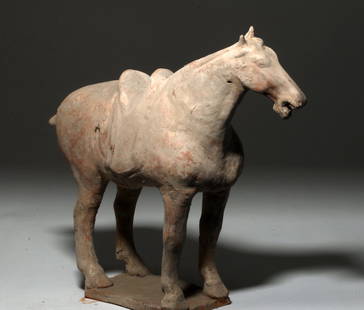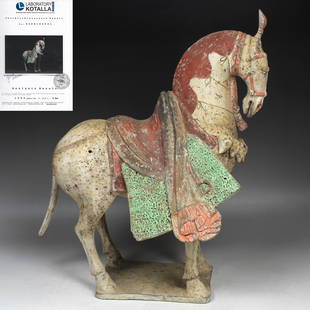
Museum-Exhibited Chinese Tang Dynasty Horse & Rider
Similar Sale History
View More Items in Sculptures & Carvings
Related Sculptures & Carvings
More Items in Tang Dynasty Sculptures & Carvings
View MoreRecommended Art
View More











Item Details
Description
East Asia, China, Tang Dynasty, ca. 618 to 906 CE. A regal and pleasantly plump terracotta court lady on horseback feeding a dove, most likely a funerary object of strong symbolic import, mold-made from the Tang Dynasty with remains of red, black, and white pigment. The horse grew very significant during the expansion of the Tang golden age. This impressive charger served as both a symbol of imperial stability that engendered bountiful trade and prosperity for the expanding empire and the reward of military exploits to the west. The most cherished horses were raised in the western kingdom of Ferghana and known as "blood-sweating horses." These were delivered as tribute to the reigning emperor. In general, for the ancient Chinese, horses were a sign of wealth.
The female figure demonstrates the hallmarks of the Tang Dynasty style, with her naturalistically rendered, softly contoured round face embellished with meticulously detailed features, her untailored, loose robe with flowing sleeves cascading over her form, as well as her elaborate coiffure with hair piled up toward the side, a particular fashion of the time. While early Tang female figures are comparatively slender, by the mid 8th century CE more voluptuous bodies with full faces and hairstyles described as cloudlike by experts in the field were in favor. Scholars have attributed this shift to Emperor Xuanzong's infatuation with a rather full-figured concubine, the legendary beauty named Yang Guifei. This said, female figures of this body type have been discovered from eras previous to Xuanzong; hence, this embrace of the full figure may simply reflect a change in ideal body types. (For further reading, see Fontein, Jan, Tung Wu, and Museum of Fine Arts, Boston. 1973. Unearthing China’s Past, p. 175.)
As for the significance of the dove, during the Tang Dynasty, the dove was an element featured in the headdress of the Great Goddess who is usually described as the "goddess who sends children." Hence the ancients linked fertility to the Great Goddess who wore a dove in her headdress. Here the court lady is feeding the fluttering dove perched upon her left palm a biscuit presented in her right hand -likely a reference to fertility.
Overall, a very rare example from the Tang Dynasty displaying exceptional artistry and technique and offering layers of iconographical meaning that was displayed in the Denver Art Museum. Size: 8.875" L x 3" W x 9.875" H (22.5 cm x 7.6 cm x 25.1 cm)
Provenance: Ex- Sarkisian Gallery, Denver, CO acquired in the 1950's.(Old label on bottom reads, "Yamanaka & Co. 680 Fifth Avenue, New York, NY." Displayed, Denver Art Museum, 1960's.
All items legal to buy/sell under U.S. Statute covering cultural patrimony Code 2600, CHAPTER 14, and are guaranteed to be as described or your money back.
A Certificate of Authenticity will accompany all winning bids.
We ship worldwide and handle all shipping in-house for your convenience.
#112746
The female figure demonstrates the hallmarks of the Tang Dynasty style, with her naturalistically rendered, softly contoured round face embellished with meticulously detailed features, her untailored, loose robe with flowing sleeves cascading over her form, as well as her elaborate coiffure with hair piled up toward the side, a particular fashion of the time. While early Tang female figures are comparatively slender, by the mid 8th century CE more voluptuous bodies with full faces and hairstyles described as cloudlike by experts in the field were in favor. Scholars have attributed this shift to Emperor Xuanzong's infatuation with a rather full-figured concubine, the legendary beauty named Yang Guifei. This said, female figures of this body type have been discovered from eras previous to Xuanzong; hence, this embrace of the full figure may simply reflect a change in ideal body types. (For further reading, see Fontein, Jan, Tung Wu, and Museum of Fine Arts, Boston. 1973. Unearthing China’s Past, p. 175.)
As for the significance of the dove, during the Tang Dynasty, the dove was an element featured in the headdress of the Great Goddess who is usually described as the "goddess who sends children." Hence the ancients linked fertility to the Great Goddess who wore a dove in her headdress. Here the court lady is feeding the fluttering dove perched upon her left palm a biscuit presented in her right hand -likely a reference to fertility.
Overall, a very rare example from the Tang Dynasty displaying exceptional artistry and technique and offering layers of iconographical meaning that was displayed in the Denver Art Museum. Size: 8.875" L x 3" W x 9.875" H (22.5 cm x 7.6 cm x 25.1 cm)
Provenance: Ex- Sarkisian Gallery, Denver, CO acquired in the 1950's.(Old label on bottom reads, "Yamanaka & Co. 680 Fifth Avenue, New York, NY." Displayed, Denver Art Museum, 1960's.
All items legal to buy/sell under U.S. Statute covering cultural patrimony Code 2600, CHAPTER 14, and are guaranteed to be as described or your money back.
A Certificate of Authenticity will accompany all winning bids.
We ship worldwide and handle all shipping in-house for your convenience.
#112746
Condition
Horse legs repaired. Otherwise intact with expected paint losses as shown.
Buyer's Premium
- 22.5%
Museum-Exhibited Chinese Tang Dynasty Horse & Rider
Estimate $7,000 - $9,000
9 bidders are watching this item.
Get approved to bid.
Shipping & Pickup Options
Item located in Boulder County, CO, usSee Policy for Shipping
Payment

TOP








































































